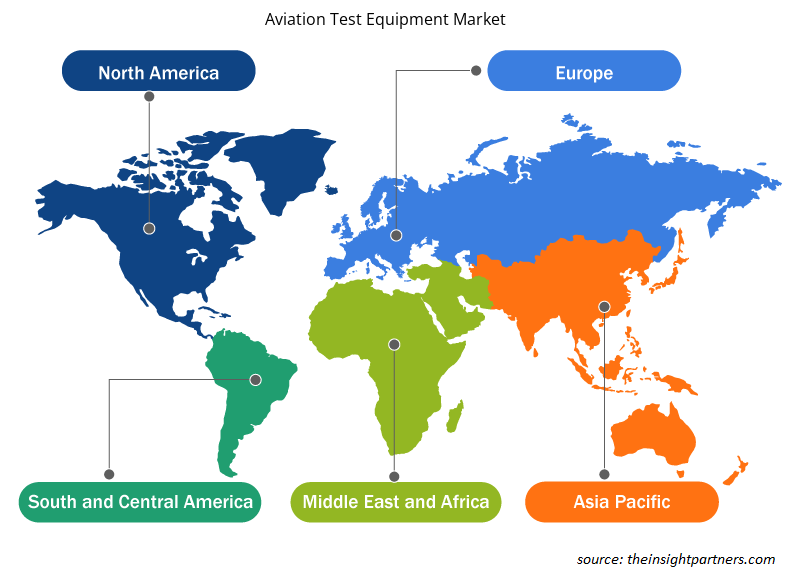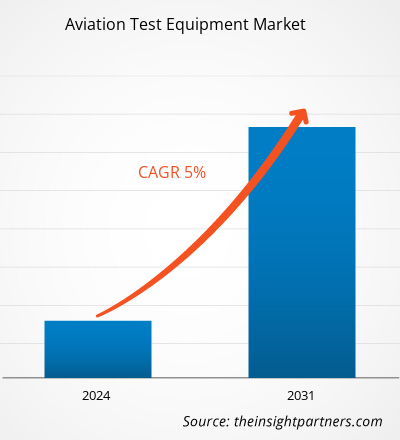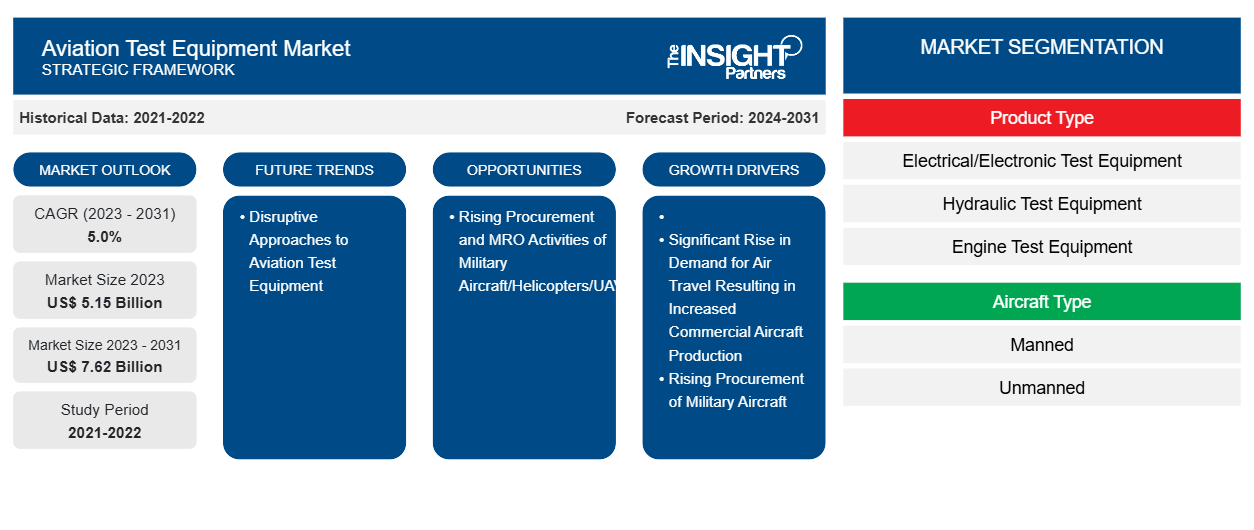Der Markt für Testgeräte für die Luftfahrt wird voraussichtlich von 5,15 Milliarden US-Dollar im Jahr 2023 auf 7,62 Milliarden US-Dollar im Jahr 2031 wachsen. Der Markt soll zwischen 2023 und 2031 eine durchschnittliche jährliche Wachstumsrate (CAGR) von 5,0 % verzeichnen. Die Einführung von Technologien der nächsten Generation in den letzten Jahren hat zu einer Weiterentwicklung der Testgeräte für die Luftfahrt geführt – beispielsweise zur Einführung des weltweit ersten Robotertesters für Cockpit-Bedienfelder. Hersteller von Testgeräten für die Luftfahrt bringen außerdem bahnbrechende innovative technologische Modelle auf den Markt, die den Test- und Evaluierungsprozess von Flugzeugsystemen und -komponenten vereinfachen. Darüber hinaus bündeln Unternehmen ihre Kräfte, um komplette Testlösungen für kommerzielle und militärische Flugzeuge anzubieten. Testek und Avtron Aerospace bieten beispielsweise ein breites Spektrum an Flugzeugtests von der Entwicklung über die Herstellung bis hin zum Komponenten- und Plattformdesign an. Und Barfield, eine US-Tochtergesellschaft der Aero Maintenance Group LLC, bietet 3D-Scantechnologie zur Inspektion und Evaluierung von Hagelschäden an Flugzeugen an.
Marktanalyse für Testgeräte für die Luftfahrt
Die Flugzeughersteller weltweit verzeichnen aufgrund der steigenden Zahl von Flugreisenden, Militärbewegungen, Frachtvolumen und kampfbereiten Flugzeugen eine erhebliche Nachfrage seitens ihrer Kunden. Die ständig steigende Beschaffung von Flugzeugen, sowohl für den kommerziellen als auch für den militärischen Bereich , zwingt die Flugzeughersteller, eine größere Menge an Testgeräten zu beschaffen. Die schiere Nachfrage der Flugzeughersteller nach diesen Geräten hat zu einer Zunahme der Hersteller von Testgeräten geführt. Eine große Anzahl von Herstellern von Testgeräten kommt den Käufern zugute, da dies den Vergleich zwischen verschiedenen Lieferanten je nach ihren Produkten, Lieferzeiten, Vertragswerten und Markenwert erleichtert.
Marktübersicht für Luftfahrttestgeräte
Das Ökosystem für Luftfahrttestgeräte besteht aus verschiedenen Phasen, die außerdem spezielle Verfahren umfassen. Mit dem Ziel, die Kundenerwartungen zu erfüllen, bemühen sich die Marktteilnehmer auf dem Markt für Luftfahrttestgeräte, robuste Produkte und Dienstleistungen anzubieten. Die weltweit tätigen Hersteller von Testgeräten beziehen verschiedene Komponenten von unterschiedlichen Lieferanten. Verschiedene Lieferanten liefern Komponenten wie Sensoren, Datenlogger, Druckmesser und Displays. Diese Komponentenlieferanten stehen regelmäßig unter enormem Druck der Hersteller von Testgeräten, ihre Produkte zu liefern. Der Markenwert der Komponentenlieferanten ist von größter Bedeutung, da die Qualität der Komponenten für die Herstellung von Testgeräten bester Qualität entscheidend ist. Mit dem Ziel, langfristige Geschäftsbeziehungen aufrechtzuerhalten, bemühen sich die Komponentenlieferanten nach Kräften, Produkte höchster Qualität zu einem wettbewerbsfähigen Preis zu liefern. Die Lieferzeit ist ein weiterer Parameter, auf den die Komponentenlieferanten Wert legen.
Passen Sie diesen Bericht Ihren Anforderungen an
Sie erhalten kostenlos individuelle Anpassungen an jedem Bericht, einschließlich Teilen dieses Berichts oder einer Analyse auf Länderebene, eines Excel-Datenpakets sowie tolle Angebote und Rabatte für Start-ups und Universitäten.
- Holen Sie sich die wichtigsten Markttrends aus diesem Bericht.Dieses KOSTENLOSE Beispiel umfasst eine Datenanalyse von Markttrends bis hin zu Schätzungen und Prognosen.
Treiber und Chancen auf dem Markt für Testgeräte für die Luftfahrt
Deutlicher Anstieg der Nachfrage nach Flugreisen führt zu einer erhöhten Produktion von Verkehrsflugzeugen
Der globale Luftfahrtsektor verzeichnet eine steigende Nachfrage nach neuen Flugzeugmodellen, um die Gesamtflotte zu vergrößern. Dies ist einer der Hauptfaktoren, die das Wachstum des Marktes für Testgeräte für die Luftfahrt vorantreiben. Der steigende Passagierverkehr wird voraussichtlich die Zahl der Flugzeugbeschaffungen weiter erhöhen und die Nachfrage nach Testgeräten im Luftfahrtsektor ankurbeln. Darüber hinaus belief sich die Gesamtflotte der Verkehrsflugzeuge im Jahr 2022 in verschiedenen Regionen auf rund 27.385 und erreichte im Jahr 2023 einen Zuwachs von rund tausend Flugzeugen in einem einzigen Jahr. Solche Faktoren haben das Wachstum des Marktes für Testgeräte für die Luftfahrt in verschiedenen Regionen vorangetrieben.
Steigende Beschaffungs- und MRO-Aktivitäten für Militärflugzeuge/-hubschrauber/-UAVsMRO Activities of Military Aircraft/Helicopters/UAVs
Die steigende Beschaffung von Militärflugzeugen und -hubschraubern ist ein weiterer wichtiger Faktor, der die Beschaffung von Luftfahrttestgeräten in verschiedenen Regionen wahrscheinlich ankurbeln wird. Darüber hinaus umfassen die Anwendungen von Luftfahrttestgeräten in Militärflugzeugen die Triebwerkswartung, die Fahrwerkswartung, die Avionikwartung und vieles mehr. Die wachsende MRO-Branche für die Luftfahrt ist ein weiterer wichtiger Faktor, der im Prognosezeitraum wahrscheinlich neue Möglichkeiten für Marktanbieter schaffen wird.MRO industry is another major factor likely to generate new opportunities for market vendors during the forecast period.
Darüber hinaus dürfte der zunehmende Einsatz von UAVs bei den Streitkräften verschiedener Länder den Einsatz von Flugtestgeräten bei den Streitkräften und MRO-Unternehmen, die Dienstleistungen für Militärflugzeuge/-hubschrauber/UAVs anbieten, vorantreiben.UAVs in the military forces of different countries is another major factor expected to boost the deployment of aviation test equipment among the armed forces and MRO companies that provide services for military aircraft/helicopters/UAVs.
Segmentierungsanalyse des Marktberichts für Luftfahrttestgeräte
Wichtige Segmente, die zur Ableitung der Marktanalyse für Luftfahrttestgeräte beigetragen haben, sind Produkttyp, Flugzeugtyp, Endbenutzer und Geografie.
- Basierend auf dem Produkttyp wurde der Markt für Luftfahrtprüfgeräte in elektrische/elektronische Prüfgeräte, hydraulische Prüfgeräte, Motorprüfgeräte und pneumatische Prüfgeräte segmentiert. Das Segment der elektrischen/elektronischen Prüfgeräte hatte im Jahr 2023 einen größeren Marktanteil.
- Nach Flugzeugtyp wurde der Markt für Luftfahrttestgeräte in bemannte und unbemannte Flugzeuge segmentiert. Das bemannte Segment hielt im Jahr 2023 den größten Marktanteil.
- In Bezug auf den Endverbraucher wurde der Markt für Luftfahrttestgeräte in kommerzielle und militärische Segmente unterteilt. Das kommerzielle Segment dominierte den Markt im Jahr 2023.
Marktanteilsanalyse für Luftfahrttestgeräte nach Geografie
Der geografische Umfang des Marktberichts für Luftfahrttestgeräte ist hauptsächlich in fünf Regionen unterteilt: Nordamerika, Europa, Asien-Pazifik, Naher Osten und Afrika sowie Südamerika.
Nordamerika dominiert den Markt für Luftfahrttestgeräte im Jahr 2023, während die Region Asien-Pazifik im Prognosezeitraum voraussichtlich die höchste durchschnittliche jährliche Wachstumsrate verzeichnen wird. Dies ist auf das Wachstum der Flugzeugproduktion verschiedener OEMs wie Boeing, Airbus, Textron, Bombardier, Bell Helicopters, Lockheed Martin Corporation und Northrop Grumman Corporation zurückzuführen. Diese Unternehmen erhalten größere Flugzeugaufträge von verschiedenen Kunden aus der ganzen Welt, was die Nachfrage nach Luftfahrttestgeräten in der gesamten Region Nordamerika weiter ankurbelt.
Regionale Einblicke in den Markt für Luftfahrttestgeräte
Die regionalen Trends und Faktoren, die den Markt für Luftfahrttestgeräte im Prognosezeitraum beeinflussen, wurden von den Analysten von Insight Partners ausführlich erläutert. In diesem Abschnitt werden auch die Marktsegmente und die Geografie von Luftfahrttestgeräten in Nordamerika, Europa, im asiatisch-pazifischen Raum, im Nahen Osten und Afrika sowie in Süd- und Mittelamerika erörtert.

- Erhalten Sie regionale Daten zum Markt für Testgeräte für die Luftfahrt
Umfang des Marktberichts über Testgeräte für die Luftfahrt
| Berichtsattribut | Details |
|---|---|
| Marktgröße im Jahr 2023 | 5,15 Milliarden US-Dollar |
| Marktgröße bis 2031 | 7,62 Milliarden US-Dollar |
| Globale CAGR (2023 - 2031) | 5,0 % |
| Historische Daten | 2021-2022 |
| Prognosezeitraum | 2024–2031 |
| Abgedeckte Segmente | Nach Produkttyp
|
| Abgedeckte Regionen und Länder | Nordamerika
|
| Marktführer und wichtige Unternehmensprofile |
|
Dichte der Marktteilnehmer für Testgeräte für die Luftfahrt: Die Auswirkungen auf die Geschäftsdynamik verstehen
Der Markt für Luftfahrttestgeräte wächst rasant, angetrieben durch die steigende Nachfrage der Endnutzer aufgrund von Faktoren wie sich entwickelnden Verbraucherpräferenzen, technologischen Fortschritten und einem größeren Bewusstsein für die Vorteile des Produkts. Mit steigender Nachfrage erweitern Unternehmen ihr Angebot, entwickeln Innovationen, um die Bedürfnisse der Verbraucher zu erfüllen, und nutzen neue Trends, was das Marktwachstum weiter ankurbelt.
Die Marktteilnehmerdichte bezieht sich auf die Verteilung der Firmen oder Unternehmen, die in einem bestimmten Markt oder einer bestimmten Branche tätig sind. Sie gibt an, wie viele Wettbewerber (Marktteilnehmer) in einem bestimmten Marktraum im Verhältnis zu seiner Größe oder seinem gesamten Marktwert präsent sind.
Die wichtigsten auf dem Markt für Prüfgeräte für die Luftfahrt tätigen Unternehmen sind:
- Astronics Corporation
- Avtron Aerospace, Inc.
- BAE Systems
- Bauer Inc.
- ECA-Gruppe
- Hydraulics International Inc.
Haftungsausschluss : Die oben aufgeführten Unternehmen sind nicht in einer bestimmten Reihenfolge aufgeführt.

- Überblick über die wichtigsten Akteure auf dem Markt für Testgeräte für die Luftfahrt
Neuigkeiten und aktuelle Entwicklungen zum Markt für Testgeräte in der Luftfahrt
Der Markt für Luftfahrttestgeräte wird durch die Erfassung qualitativer und quantitativer Daten nach Primär- und Sekundärforschung bewertet, die wichtige Unternehmensveröffentlichungen, Verbandsdaten und Datenbanken umfasst. Im Folgenden finden Sie eine Liste der Entwicklungen auf dem Markt für Luftfahrttestgeräte und Strategien:
- Im Mai 2023 brachte ATEQ Aviation seinen brandneuen Batterieanalysator ATEQ BA 1500 und sein neues Batterieladegerät ATEQ BC 1500 auf den Markt. (Quelle: ATEQ Aviation, Pressemitteilung/Unternehmenswebsite/Newsletter)
- Im Juli 2022 haben Airbus und CFM International, ein 50/50-Joint-Venture von GE und Safran Aircraft Engines, gemeinsam die hochmoderne Open-Fan-Triebwerksarchitektur von CFM getestet. (Quelle: Airbus, Pressemitteilung/Unternehmenswebsite/Newsletter)
Marktbericht zu Testgeräten für die Luftfahrt – Umfang und Ergebnisse
Der Bericht „Marktgröße und Prognose für Luftfahrttestgeräte (2021–2031)“ bietet eine detaillierte Analyse des Marktes, die die folgenden Bereiche abdeckt:
- Marktgröße und Prognose auf globaler, regionaler und Länderebene für alle wichtigen Marktsegmente, die im Rahmen des Projekts abgedeckt sind
- Marktdynamik wie Treiber, Beschränkungen und wichtige Chancen
- Wichtige Zukunftstrends
- Detaillierte Porter's Five Forces Analyse
- Globale und regionale Marktanalyse mit wichtigen Markttrends, wichtigen Akteuren, Vorschriften und aktuellen Marktentwicklungen
- Branchenlandschaft und Wettbewerbsanalyse, einschließlich Marktkonzentration, Heatmap-Analyse, prominenten Akteuren und aktuellen Entwicklungen
- Detaillierte Firmenprofile mit SWOT-Analyse
- Historische Analyse (2 Jahre), Basisjahr, Prognose (7 Jahre) mit CAGR
- PEST- und SWOT-Analyse
- Marktgröße Wert/Volumen – Global, Regional, Land
- Branchen- und Wettbewerbslandschaft
- Excel-Datensatz
Aktuelle Berichte
Erfahrungsberichte
Grund zum Kauf
- Fundierte Entscheidungsfindung
- Marktdynamik verstehen
- Wettbewerbsanalyse
- Kundeneinblicke
- Marktprognosen
- Risikominimierung
- Strategische Planung
- Investitionsbegründung
- Identifizierung neuer Märkte
- Verbesserung von Marketingstrategien
- Steigerung der Betriebseffizienz
- Anpassung an regulatorische Trends





















 Kostenlose Probe anfordern für - Markt für Luftfahrttestgeräte
Kostenlose Probe anfordern für - Markt für Luftfahrttestgeräte